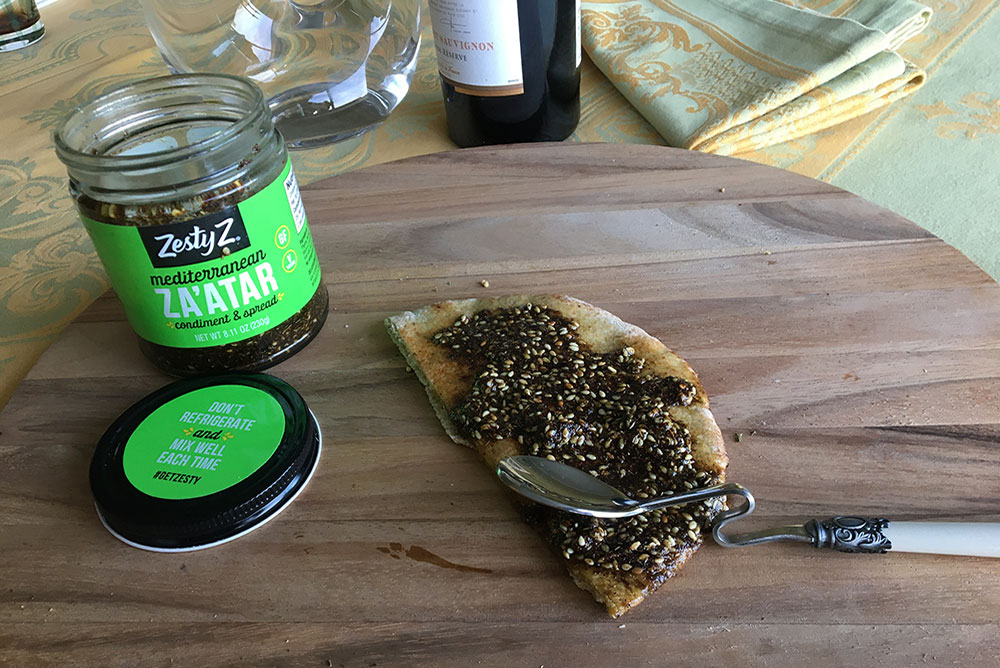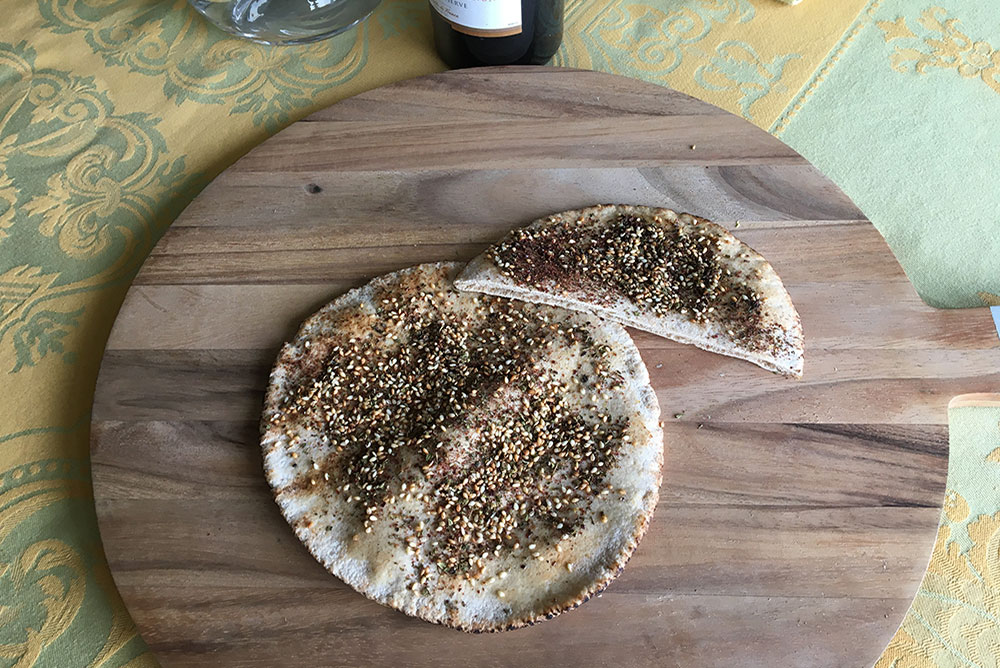
Za’atar bread made with the commercial spread from Zesty Z. / MyLittleBird photo.
I WAS SUPPOSED to write about something else this week, then I got sidetracked. The culprit? The Middle East. Yes, of course I can explain.
Inviting a few old friends to lunch isn’t supposed to be stressful. Sensing that the opposite was the case, one friend suggested that I put my faith in a good Middle Eastern restaurant and have it deliver some mezze, a selection of hummus and tabbouleh and pita and feta cheese, etcetera—the quintessential Mediterranean nosh. But which restaurant? Ack! So instead, I lit on something easy: baked salmon and a green salad and . . . and . . . what? Those two menu items are somewhat lacking in zip without loading one or both with some kind of dressing or sauce.
And so began my search for za’atar bread. The mention of mezze had rolled my mind’s taste buds back years to the tasty pita bread I used to buy at Mediterranean Bakery in Alexandria, Virginia. Atop the bread was a lovely, almost dusty coating of toasted sesame seeds and dried thyme and oregano and sumac, that last with its rich, lemony tang.
With no za’atar bread locally (“locally” being defined by me as within five blocks of my apartment), I scouted around for the za’atar spice. No go there either.
Long story even longer, I found Zesty Z, the Middle Eastern spice combo (Lebanese in this iteration) in an olive oil suspension, made in Brooklyn and sold in supermarkets and online. And, to prove that once you’ve seen something once you will see it everywhere, Amazon (of course) offered an almost endless array of za’atar spice blends, plus individual jars of the ingredients to make my own, including the elusive sumac (pronounced SHOO-mock).

Made with my own spice blend and quite a bit less olive oil, this za’atar bread is less unctuous but still quite tasty. / MyLittleBird photo.
For that lunch, I used the Zesty Z za’atar spread, toasting the pita after slathering the oily substance atop the little loaves and cutting them in quarters. (Yum!) Next day, I launched an assault on my own za’atar blend. Judging by the myriad recipes out there, the exact ingredients and their proportions vary by country, even city, and are limited by your own palate, to a certain extent. Some of the recipes call for starting with za’atar leaves, but to be honest, it’s not clear to me whether a za’atar plant is simply a variant on oregano. No matter. With what I had in the pantry, here’s what I wound up with.
No-Nonsense Za’atar Bread
2 tablespoons of sesame seeds
2 tablespoons of dried oregano
1 tablespoon of ground sumac
Olive oil
Pita bread (commercial or, if you’re really into it, your own)
NOTE: Most recipes seem to call for adding a little salt, but I didn’t discern the need for any. Also, using dried thyme instead of oregano will shift the flavor profile, probably making it closer to the Mediterranean Bakery version. Additionally, some recipes call for ground cumin and coriander, triggering much back-and-forth among online recipe readers about authenticity; it seems to be of the Minsk-versus-Pinsk variety, meaning where in the wide expanse of the Middle East each reader’s taste buds and traditions were formed. This all suggests delightful future experimentation.
In one or two batches, toast the sesame seeds in a dry skillet over a medium flame until they’re medium brown (you can also use a toaster oven, laying the seeds out on a toaster-oven tray). Remove to a medium-size bowl and allow to cool.
When the sesame seeds are cool, mix in the oregano and sumac and grind the three ingredients together (you may want to use a mortar and pestle, but just bruising them together works well enough).
Lightly coat each pita with a bit of olive oil. Sprinkle on some of the spice blend, as lightly or as densely as you want. A few minutes in a toaster oven brings everything together but is not entirely necessary.
The remainder of the dry spice blend can be stored in a small air-tight container along with your other spices and used on those bereft-looking chicken breasts sitting there begging for flavor, or on vegetables. If you get hooked on the taste of za’atar, the spice blend can be sprinkled on popcorn (perhaps with a quick spray of olive oil to help it adhere) or as a variation on classic Chex party mix. Your Lebanese great-grandmother will be proud . . or horrified, hard to know.
—Nancy McKeon
MyLittleBird often includes links to products we write about. Our editorial choices are made independently; nonetheless, a purchase made through such a link can sometimes result in MyLittleBird receiving a commission on the sale, whether through a retailer, an online store or Amazon.com.

I buy several types of za’atar whenever I get to Kalustyan’s in NYC. Every Middle Eastern cuisine has its own iteration. The store itself is Disneyland for cooks.
I bought za’atar at Penzey’s here. Terrific spice selection. The one I bought has sumac and sesame seeds already in the mix.